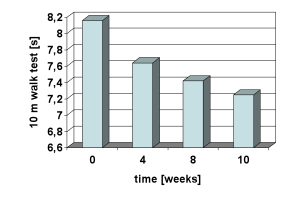J Musculoskelet Neuronal Interact, 2016; 16(4): 327-338, PMID: 27973385 ![]()
Acute corticospinal and spinal modulation after whole body vibration.
Krause A, Gollhofer A, Freyler K, Jablonka L, Ritzmann R
Department of Sport Science, University of Freiburg, Freiburg, Germany.
Abstract
OBJECTIVES: The objective of this study was to investigate neural effects of acute whole body vibration (WBV) on lower limb muscles regarding corticospinal and spinal excitability.
METHODS: In 44 healthy subjects (16 f/ 28 m), motor evoked potentials (MEP) and H-reflexes in m. soleus (SOL) and gastrocnemius medialis (GM) were elicited before (t1), immediately after (t2), 2 (t3), 4 (t4) and 10 min after (t5) WBV.
RESULTS: After WBV, MEP amplitudes were significantly increased in SOL (t2+15+/-30%, t3+22+/-32%, t4+15+/-35%, t5+20+/-30%, P<0.05), but not in GM (t2+32+/-62%, t3+9+/-35%, t4+8+/-36%, t5+22+/-47%; P=0.07). Contrarily, H-reflexes were significantly reduced in SOL (t2-19+/-28%, t3-21+/-22%, t4-20+/-21%, t5-14+/-28%, P<0.05) and GM (t2-14+/-37%, t3-16+/-25%, t4-18+/-29%, t5-16+/-28%, P<0.05).
CONCLUSIONS: A temporary sustained enhancement of corticospinal excitability concomitant with spinal inhibition after WBV points towards persisting neural modulation in the central nervous system. This could indicate greater neural modulation over M1 and descending pathways, while the contribution of spinal pathways is reduced.



 Compared with baseline measurements, the 10-m walk test showed significant improvements in 2, 8 and 10 m times at 8 week and 2 week post-vibration. Timed up-and-go demonstrated a significant and positive time effect. Standing balance showed significant improvements from baseline, at 4- and 2-weeks post-vibration
Compared with baseline measurements, the 10-m walk test showed significant improvements in 2, 8 and 10 m times at 8 week and 2 week post-vibration. Timed up-and-go demonstrated a significant and positive time effect. Standing balance showed significant improvements from baseline, at 4- and 2-weeks post-vibration